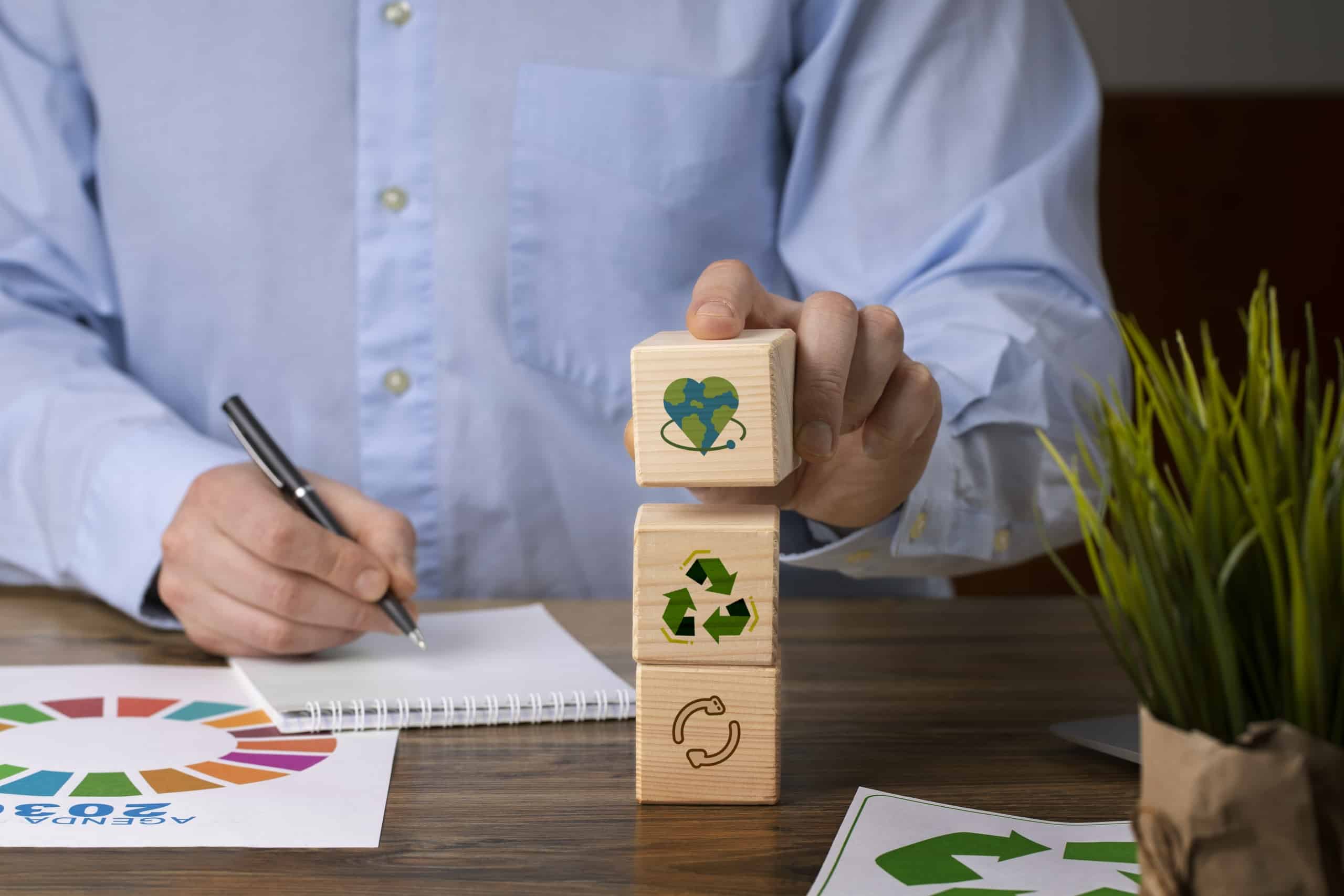1. Streamlined Use of Sustainable Materials
The selection of materials is crucial in the process of becoming a greener wet wipes manufacturer, and contemporary wet wipes equipment is designed to satisfy the requirements of environmentally aware manufacturing. These devices are designed to precisely and effectively handle sustainable materials including cellulose-based sheets, bamboo fibers, and organic cotton. These environmentally friendly materials, in contrast to traditional substrates, can pose special difficulties, such as increased fragility and textural variety. Modern equipment, on the other hand, overcomes these difficulties with novel features like accurate tension controls, feed mechanisms that are optimized, and adjustable settings that save waste and guarantee faultless production.
To prevent rips and minimize material waste, machines with precise tension control systems, for example, make sure that fragile biodegradable materials are fed smoothly through the manufacturing line. In addition to promoting sustainability, this capacity dramatically improves cost efficiency since it allows wet wipes manufacturers to produce more with the same amount of raw resources. Further lowering the total amount of raw materials used, contemporary machinery can manufacture thinner biodegradable sheets without sacrificing the finished product’s structural integrity.
In addition to managing materials efficiently, these devices allow for smooth transitions between different kinds of materials, allowing wet wipes manufacturers to alternate between conventional and sustainable solutions as market needs change. For wet wipes manufacturers looking to investigate eco-friendly product lines or satisfy diverse consumer demands across several geographies, this flexibility is essential. Wet wipes manufacturers may securely include sustainable materials into their manufacturing processes by utilizing such technology, opening the door for ecologically conscious wet wipes that appeal to today’s conscientious customers.
2. Optimized Water and Energy Usage
Reducing water and energy usage is one of the most important issues facing contemporary production, and wet wipes equipment is stepping up to the task with creative solutions. Modern wet wipers are made with closed-loop water circuits and accurate dosing mechanisms to maximize water use. By ensuring that each wipe only receives the precise amount of water or lotion, these systems save waste while preserving the quality of the final product. By recycling water used in manufacturing, closed-loop water systems greatly lower the overall water footprint while also increasing efficiency.
Another aspect in which contemporary wet wipes equipment shines is energy economy. These wet wipes machines use far less energy than their predecessors because of the integration of heat recovery technology, sophisticated power management systems, and energy-efficient motors. Servo motors, which are frequently used in modern technology, provide regulated and accurate motions while using less energy than is necessary. In order to power additional machine components and provide a more economical and sustainable operation, heat recovery systems collect and repurpose energy produced during manufacturing, such as during sealing procedures.
Optimizing water and energy use has both economic and environmental benefits. Lower operating expenses due to reduced resource usage free up funds for manufacturers to use for other purposes, including production scaling or innovation. Furthermore, government incentives and international sustainability requirements are frequently aligned with energy-efficient gear, which makes it simpler for firms to satisfy carbon reduction targets or get certifications like ISO 14001. Wet wipes manufacturers may enhance their bottom line and help create a more environmentally friendly future by including these cutting-edge technologies, which benefit both companies and the environment.
3. Automated Waste Management
The way wet wipes manufacturers handle manufacturing flaws and byproducts has been completely transformed by the integration of automated waste management systems into wet wipes equipment. Because of cutting, misalignment, or incorrect outputs, traditional manufacturing processes frequently produce large amounts of waste. This problem is solved by sophisticated wet wipes equipment that incorporates real-time trash collection and recycling capabilities, guaranteeing that waste materials are effectively handled and recycled wherever feasible.
For instance, cutting-related trim waste is now automatically collected and recycled back into the manufacturing line or processed for other applications, including making electricity or packaging. By significantly reducing the amount of waste, these solutions assist manufacturers in lessening their environmental effects. Furthermore, only premium wet wipes are released into the market thanks to the automatic separation of faulty items, which also avoids wasting other resources that may still be put to good use.
In addition to reducing waste, these devices have AI-powered monitoring systems and smart sensors that continually scan manufacturing lines for inefficiencies. When a flaw is found, the system not only separates the faulty product but also offers information about the underlying cause, allowing for prompt fixes to save more waste. This degree of automation increases overall production efficiency by minimizing downtime and reducing material loss.
Furthermore, automated waste management systems support the circular economy’s tenets. Wet wipes manufacturers may establish themselves as environmentally conscious leaders in their sector by reusing leftovers and reducing their input to landfills. The combination of these systems strengthens the business case for more environmentally friendly production methods by showing how state-of-the-art equipment can turn waste management into a chance for sustainability and cost savings.
4. Reduced Packaging Footprint
Packaging plays a crucial role in the wet wipes sector, affecting both the environmental effect and consumer attractiveness. By facilitating the use of environmentally friendly materials and lowering the overall package footprint, modern wet wipes equipment meets the demand for more sustainable packaging solutions. Wet wipes manufacturers may now easily incorporate creative, lightweight, and recyclable packaging choices into their production lines thanks to developments in machinery design.
The fact that these wet wipes machines can work with materials like recyclable plastics, biodegradable films, and even paper-based packaging is one of the major advances. Because of their fragility or particular characteristics, traditional machinery frequently has trouble working with these materials. However, newer equipment has specialized tension controls and sealing systems to guarantee seamless operation. This feature enables companies to switch from traditional plastic packaging to more environmentally friendly options without sacrificing the safety of their products or their visual attractiveness.
Additionally, designs that use less material are supported by current machinery. For instance, wet wipes manufacturers can use thinner, more resilient films or more compact package styles to use less material per unit. It is now possible to effectively include features like resealable closures, increasing customer convenience and reducing waste from single-use packaging. In addition to appealing to shoppers who care about the environment, this also complies with laws that limit unnecessary packaging in some markets.
Packaging sustainability is further improved by automation. In order to reduce material waste during manufacturing, advanced technology improves the alignment, cutting, and sealing operations. Additionally, producers can monitor and enhance their packaging methods thanks to data-driven insights from IoT-enabled devices, guaranteeing ongoing resource efficiency improvements.
Wet wipes manufacturers may fulfill customer demand for eco-friendly products while lowering their environmental impact by implementing equipment that promotes sustainable packaging. This investment supports a broader trend toward ethical production methods in addition to helping companies maintain their competitiveness in a market driven by sustainability.
5. Customization for Green Manufacturing
The flexibility of contemporary wet wipes equipment to provide unmatched customization is one of its biggest benefits, as it makes it simpler for producers to comply with green manufacturing standards. The capacity to create a large range of environmentally friendly products that are suited to various requirements and tastes is revolutionary in a market that is becoming more and more driven by customers who are concerned about sustainability.
Modern wet wipers are made to work with a variety of substrates, such as recyclable, biodegradable, and compostable materials. Because of its adaptability, producers may try out novel materials like bamboo fibers, organic cotton, or plant-based cellulose without having to make significant changes. Brands can swiftly adjust to new sustainability trends or regulatory changes by using a smooth transition between materials, which helps them stay relevant in a changing marketplace.
Product forms can also be customized. To meet the needs of niche markets like baby care, medical-grade wipes, or environmentally friendly travel packs, modern machines can produce wipes in a variety of sizes, thicknesses, and packaging styles. To preserve efficiency and reduce resource waste, a wet wipes manufacturer may, for example, utilize a single machine to create biodegradable disinfection wipes one day and conventional wet wipes the next. This degree of adaptability helps businesses to investigate new income sources with customized eco-friendly items in addition to promoting greener production.
Additionally, enterprises may improve manufacturing processes for sustainability with customizable machinery. It is possible to program machines to use less material, use less energy, and produce less trash. For instance, using a wet wipes machine to apply lotion more accurately might cut manufacturing costs overall and improve environmental advantages by using less liquid every wipe.
In a crowded market, the flexibility to adapt production for green manufacturing makes businesses stand out. Businesses may improve their reputation, grow their clientele, and help create a more sustainable future by providing sustainable solutions that are suited to the tastes of eco-aware consumers. Purchasing adaptable machinery is a calculated decision that sets up companies for long-term success in a sector that is becoming more environmentally conscious. It is not only a step toward sustainability.
6. Data-Driven Sustainability
Wet wipes manufacturers’ approaches to sustainability are being completely transformed by the incorporation of data analytics and Internet of Things (IoT) technologies into wet wipes equipment. Businesses may optimize all facets of their manufacturing processes to eliminate waste, improve operational efficiency, and lessen their impact on the environment by utilizing real-time data insights. A significant step in bringing manufacturing methods into compliance with international eco-conscious norms is the transition to data-driven sustainability.
Resource management is one important area where data has a revolutionary impact. IoT-enabled sensors included in contemporary wet wipes machines track raw material, water, and energy use in real time. These systems give wet wipes manufacturers comprehensive information on consumption trends, enabling them to spot inefficiencies and take quick remedial action. For example, data analytics may identify the problem and recommend changes to optimize energy consumption, lowering the overall carbon footprint, if a machine is consuming more energy than anticipated during the sealing process.
Data-driven systems also offer the important advantage of predictive maintenance. Sensors monitor the state of machine parts continually, anticipating possible malfunctions before they happen. In addition to avoiding expensive downtime, this increases the longevity of machines, lowering the need for frequent replacements and the environmental impact of producing new components. Wet wipes manufacturers may guarantee constant performance with little resource waste by keeping their machinery in optimal condition.
Additionally, data-driven solutions enable wet wipes manufacturers to improve product quality while preserving sustainability. Accurate control over variables like lotion application, cutting precision, and package alignment is ensured by real-time monitoring. This accuracy guarantees that faulty items are identified early in the production process and reduces material waste. Analytics may also reveal patterns in flaws or inefficiencies, allowing wet wipes manufacturers to improve their procedures for long-term sustainability benefits.
Additionally, data-driven insights assist wet wipes manufacturers in satisfying customer and regulatory needs for openness. Wet wipes manufacturers may provide thorough reports that show their dedication to environmentally friendly operations by monitoring and recording sustainability metrics. In addition to fostering trust with eco-aware customers, this openness aids in obtaining certifications and fulfilling legal requirements across a range of marketplaces.
To put it simply, data-driven sustainability turns the production of wet wipes from a reactive procedure into an intelligent, proactive system. Wet wipes manufacturers may set the stage for a more sustainable and effective future by using real-time data and analytics to influence their decisions and match them with commercial and environmental goals.
7. Compliance with Global Sustainability Standards
The production of wet wipes must now adhere to international sustainability standards as environmental consciousness continues to influence government regulations and customer behavior. To assist wet wipes manufacturers satisfy these strict criteria while preserving productivity and profitability, modern wet wipes equipment is essential. These devices guarantee that manufacturing satisfies market demands and legal requirements by using cutting-edge technology and design elements.
Reducing plastic waste is one of the most important international requirements. Wet wipes manufacturers are required by laws like the European Union’s Single-Use Plastics Directive to switch to recyclable, compostable, or biodegradable materials for their goods and packaging. Nowadays, wet wipes equipment is made especially to handle these environmentally friendly materials effectively, allowing wet wipes manufacturers to create compliant goods without sacrificing quality. Wet wipes machines with precision cutting and adaptive tension control, for instance, can operate smoothly with delicate biodegradable substrates, reducing manufacturing waste.
Materials used in wet wipes must originate from forests that are ethically managed, according to standards like the Forest Stewardship Council’s (FSC) accreditation. Modern wet wipes equipment guarantees that these materials are processed as efficiently and with the least amount of waste possible, which helps wet wipes manufacturers keep certification compliance and traceability across the supply chain. By lowering water use and enhancing resource efficiency, equipment that supports water-saving technologies also complies with ISO 14001. This is a worldwide standard for environmental management systems.
Compliance encompasses the whole production process, not simply the materials used. Regulations in some areas, for instance, require a decrease in greenhouse gas emissions throughout the production process. Energy-efficient technologies like servo motors, heat recovery systems, and real-time energy monitoring are incorporated into modern wet wipes machines to assist wet wipes manufacturers reduce their carbon footprints. By using less energy, these technologies not only guarantee regulatory compliance but also save money.
Additionally, in the worldwide market, adherence to safety and labeling regulations is crucial. Wet wipes equipment now has adaptable manufacturing lines that allow for accurate labeling and packaging to satisfy regional standards, including ingredient disclosures or environmental claims. Automated inspection systems on machines guarantee that every product satisfies strict quality requirements, lowering the possibility of recalls or fines from the government.
In the end, adhering to international sustainability standards is both a legal need and a commercial opportunity. Wet wipes manufacturers may improve their brand, draw in eco-aware customers, and obtain a competitive advantage in global marketplaces by investing in equipment that promotes environmentally responsible operations. Modern wet wipes equipment makes compliance easier and enables firms to thrive in a highly regulated sector while satisfying the aspirations of a greener future.
8. Empowering Closed-Loop Systems
Closed-loop systems are becoming a key component of environmentally friendly manufacturing practices in the quest for sustainable production. By reducing waste and increasing resource efficiency, these systems hope to establish a circular economy in which items are recycled or reused instead of being thrown away. These closed-loop systems are being made possible and empowered by sophisticated wet wipes equipment, which is revolutionizing the production and use of wet wipes.
The capacity of contemporary wet wipes equipment to handle circularity-designed materials, including recyclable packaging, biodegradable substrates, and even materials derived from post-consumer waste, is one of its primary characteristics. These devices facilitate wet wipes manufacturers’ adoption of closed-loop concepts by smoothly incorporating these materials into the production process. Wet wipes machines made to handle recycled fibers, for example, guarantee that these materials be converted into premium wet wipes without sacrificing performance or durability.
Reducing and reusing trash produced during production is another crucial component. Modern wet wipers come with automatic waste management systems that instantly identify and collect damaged and trim materials. These leftovers can be recycled back into the production process or used for secondary purposes, such as making raw materials for packaging or energy production, rather than being thrown away. This feature is in line with the circular economy’s tenets and drastically lowers the amount of garbage that is dumped in landfills.
In closed-loop systems, energy and water management are also crucial. Modern wet wipes equipment frequently has closed-loop water systems, which significantly lower water use by recycling and reusing water throughout the manufacturing process. In a similar vein, energy-efficient innovations like heat recovery systems harvest surplus energy produced during manufacturing and reroute it to power more equipment. By ensuring that resources are utilized to their maximum capacity, these characteristics reduce operating expenses and their negative effects on the environment.
Closed-loop systems are not limited to the manufacturing line. To gather used wipes and packaging from customers, several wet wipes makers are looking into creative collaborations with recycling and waste management businesses. Wet wipes manufacturers may further promote circularity and assume accountability for the lifespan of their goods by working with these organizations. To ensure compliance with post-consumer recycling systems, modern technology produces wipes and packaging that are simpler to discard or compost.
There are financial as well as environmental benefits to empowering closed-loop systems. Wet wipes manufacturers can minimize utility costs through resource optimization and save raw material costs by recycling manufacturing waste. A brand’s position as a sustainability leader is further enhanced by implementing closed-loop methods, which attract eco-aware customers and open access to premium markets.
The industry is changing as a result of wet wipes equipment that bridges the gap between sustainability and profitability thanks to its closed-loop design. These devices are paving the way for a day when sustainability is not only a goal but a norm by empowering producers to recycle materials, cut waste, and support the objectives of the circular economy.









